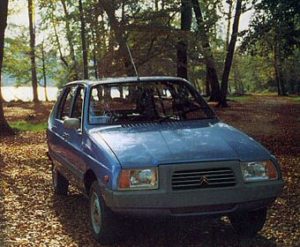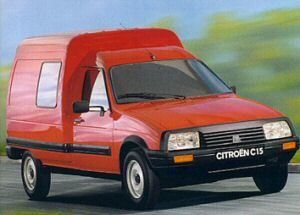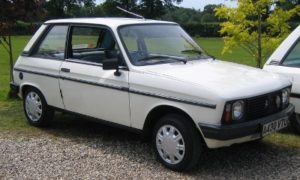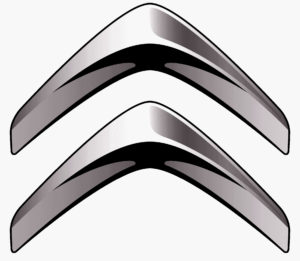After the purchase by Peugeot in 1974, Citroën badly needed to include a more conventional small family car in its range than the 2CV, Dyane and Ami.
Prior to the Peugeot purchase the original plan was to use the Fiat 127 floor pan with the Dyane/Ami8 602cc two-cylinder engine as the power plant. After the purchase the Fiat floor pan was replaced with the pan from the Peugeot 104 and in 1976 the LN was born. Apart from the engine and a handful of Citroën parts, the LN was essentially a rebadged Peugeot 104. With the Citroën public used to quirky technically challenging cars, the response was poor. The LN was not sold in the UK and manufacture for the mainland European market stopped in 1979 after 129,611 vehicles were built.
 In 1978 the 602cc two-cylinder air cooled engine in the LN was upgraded to a 652cc engine with computerised electronic ignition system, and so the more popular LNA was introduced to the Citroën public. Whilst better received than the LN before it, the LNA had the disadvantage of having the Citroën Visa, which also was introduced in 1978, as one its main competitors. Citroën’s need for a larger share of the small car market was boosted by the giving potential buyers the option of two different cars; however it affected LNA sales as the Visa had the same floor pan and engine but a totally different body styling being mostly Citroën made. LNA sales though were sufficient to continue manufacture, sold in the UK but being more popular in France and Italy. Restyled in 1982 with new headlights, rear lights, badge and plastic bumpers. At that time the 1124cc models were introduced with four cylinder water cooled engines. Latterly the special edition Inca (UK market only), which was based on the 11E including alloy wheels, two part separated rear seat, radio and special beige/brown check interior as standard. With the Visa and LNA offered at a comparable price, the more dated LNA ceased production in 1986 after 223,772 vehicles were built.
In 1978 the 602cc two-cylinder air cooled engine in the LN was upgraded to a 652cc engine with computerised electronic ignition system, and so the more popular LNA was introduced to the Citroën public. Whilst better received than the LN before it, the LNA had the disadvantage of having the Citroën Visa, which also was introduced in 1978, as one its main competitors. Citroën’s need for a larger share of the small car market was boosted by the giving potential buyers the option of two different cars; however it affected LNA sales as the Visa had the same floor pan and engine but a totally different body styling being mostly Citroën made. LNA sales though were sufficient to continue manufacture, sold in the UK but being more popular in France and Italy. Restyled in 1982 with new headlights, rear lights, badge and plastic bumpers. At that time the 1124cc models were introduced with four cylinder water cooled engines. Latterly the special edition Inca (UK market only), which was based on the 11E including alloy wheels, two part separated rear seat, radio and special beige/brown check interior as standard. With the Visa and LNA offered at a comparable price, the more dated LNA ceased production in 1986 after 223,772 vehicles were built.
The first series Visa was launched in 1978 (1979 in the UK) and seen by Citroën as the successor to the Ami 8. The Special and Club both powered by 652cc two-cylinder air cooled engines, plus the Super with an 1124cc four-cylinder water cooled engine led the way, to be followed later in France by the more powerful 1219cc special edition performance model the Super X. They were fitted with a typical Citroën satellite dash board with control pod, seats in matching strong colours to the rust-red, apple-green and yellow body colours, plus one piece front bumper and radiator housing which gave it a pig-nosed look. This made the Visa look totally different to the LNA whilst still having some major parts in common. Even with its hopefully trendy small car style, good handling and suitability for town driving, the first series Visa did not sell well in the UK and mainland Europe until it was upgraded in 1981.
After the upgrade by Heuliez, the second series Visa saw an improvement in sales. Gone were the bright fabric and body colours plus the cumbersome looking bumpers and grill, to be replaced by smoother lines and trendy plastic trim, which improved its overall appearance. From Series One the two-cylinder Special and Club continued in Series two as upgraded models until 1986; as did the 1124cc Super becoming the L and then later the 11E, with the 1124cc Super E introduced as an up-market L only to be further upgraded to become the 11RE. Of the ten special editions sold in the UK six were based on the 1124cc model. The Super E was also the starting point in 1983 for the convertible option the 11RE Plein Air or Cabriolet, the first convertible Citroën had sold since the DS Cabriolet in 1971. Due to some of the mainland European countries requiring a 1000cc model to fit their taxation laws, the Visa 10E with a 954cc four-cylinder water cooled engine and its special edition the Leader were both sold in the UK from 1986. The last of the petrol driven saloons introduced in 1984 was the luxurious 14TRS sporting a high specification upgrade including the BX 1360cc engine. Also introduced in 1984 were the 17D and 17RD based on the 11RE, but with their extremely reliable and very economic 1769cc diesel engine (later of C15 fame) plus its special edition the Leader.
 All the other models in the second series Visa range with the exception of C15 fall into the performance car category. The Super X also continued after its upgrade from Series One with the vehicles being sold in the UK as Series Two only. In 1982 the Trophee, the GT and the Chrono were all launched, only the GT was sold in the UK but both the Trophee and Chrono were imported into the UK for rallying. The Trophee was a redesigned series one Super X with its 1209cc engine enlarged to 1299cc and fitted with twin carburetors, it qualified for Group B racing (engines up to 1300cc) generating in excess of 100bhp. Only two hundred Trophee were built, but such was their success that it inspired the introduction in France of the Chrono, effectively a street version of the Trophee. A 1360cc engine and twin carburetors achieving 93bhp powered the Chrono. Its popularity was such that after an upgrade in 1983 it was sold to other mainland European countries (unfortunately not the UK), with each country having its own personalised striped livery. The GT was marketed as the successor to the Super X, powered by the same engine as both series Chrono but only achieving 80bhp as the second series Chrono. The GT had several special editions of which the Challenger was sold in the UK. Prompted by the success of the Trophee, Citroen introduced the Mille Pistes in 1983, although not sold in the UK they were again like the Trophee imported for rallying. Based on the GT, only two hundred Mille Pistes were built eligible for Group B racing, equipped with four-wheel drive and four carburetors it achieved greater success than the Trophee. Last of the Visa performance cars the GTi was introduced to the Citroen public in 1985, equipped with the Peugeot 205Gti 1580cc fuel injected engine it was capable of 105bhp, and after a further upgrade in 1987 this was increased to 115bhp. With the introduction of the AX the Visa ceased manufacture in 1988 after 1,254,390 vehicles (not including C15) were built.
All the other models in the second series Visa range with the exception of C15 fall into the performance car category. The Super X also continued after its upgrade from Series One with the vehicles being sold in the UK as Series Two only. In 1982 the Trophee, the GT and the Chrono were all launched, only the GT was sold in the UK but both the Trophee and Chrono were imported into the UK for rallying. The Trophee was a redesigned series one Super X with its 1209cc engine enlarged to 1299cc and fitted with twin carburetors, it qualified for Group B racing (engines up to 1300cc) generating in excess of 100bhp. Only two hundred Trophee were built, but such was their success that it inspired the introduction in France of the Chrono, effectively a street version of the Trophee. A 1360cc engine and twin carburetors achieving 93bhp powered the Chrono. Its popularity was such that after an upgrade in 1983 it was sold to other mainland European countries (unfortunately not the UK), with each country having its own personalised striped livery. The GT was marketed as the successor to the Super X, powered by the same engine as both series Chrono but only achieving 80bhp as the second series Chrono. The GT had several special editions of which the Challenger was sold in the UK. Prompted by the success of the Trophee, Citroen introduced the Mille Pistes in 1983, although not sold in the UK they were again like the Trophee imported for rallying. Based on the GT, only two hundred Mille Pistes were built eligible for Group B racing, equipped with four-wheel drive and four carburetors it achieved greater success than the Trophee. Last of the Visa performance cars the GTi was introduced to the Citroen public in 1985, equipped with the Peugeot 205Gti 1580cc fuel injected engine it was capable of 105bhp, and after a further upgrade in 1987 this was increased to 115bhp. With the introduction of the AX the Visa ceased manufacture in 1988 after 1,254,390 vehicles (not including C15) were built.
In 1983 Automobile Craiova commenced production of the Axel in Romania, a joint venture between Citroën and the Romanian Government. The cars were sold as the Oltcit Club in Eastern Europe and the Americas, rebadged and sold from 1984 as the Axel in Western Europe (not in the UK though). You can see the similarity visually to the Visa, however the Axel range in fact was powered by the GSA 1129cc and 1299cc engines. The Axel model range included the Axel, Axel 11R and Axel 12TRS, plus van versions the Axel 11E Entreprise and Axel 12E Entreprise. Citroën withdrew its financial backing for the venture in 1988, partially due to the poor manufacturing totals (coincidently the year that Visa manufacture finished) and when sales ceased in 1990 in the region of 100,000 cars had been sold.

The C15 has truly been a success right from the start, and this reliable economic utility vehicle has always been popular with couriers and small van fleets. Launched in 1985, they were amazingly manufactured until 2005. 1124cc petrol and 1769cc diesel engines were originally offered, which have since been upgraded to 1360cc petrol plus 1905cc and 1868cc diesel on the C15E, C15D models plus special editions the Champ and Club. Originally offered with a payload of 500kg it was increased to either 600kg or 800kg and a useable volume of 2.66m3. In the UK long and short wheel base vehicles were offered, also refrigerated equipment for the standard and box van units. In 1986 Island Plastics used the C15 as a platform to launch two versions of their very successful Romahome on the micro camper market. Initially petrol and diesel versions were offered, with the diesel version soon dominated UK sales which finished in 2001. Those of us who assumed that the introduction of the Belingo heralded the immediate demise of the C15 were wrong, being wrong for several years culminating in a total of 1,181,471 vans.
LN, LNA, Axel, Visa and C15 Model Ranges
This group of vehicles caters for a large range of the Citroën enthusiast’s needs. All of the models listed below, with the exception of the standard C15D, can be classified as rare to very rare mainly due to vehicles of the 80’s generation just rusting away. If you are interested in one of Citroen’s modern classics, in the UK the standard LNA and non-performance Visa models are still cheap. For those of you with deeper pockets to import an LN, LNA 652cc, one of the Axel range or buy one of the UK performances Visas, the price is still in most cases very reasonable. Only if you become interested in importing a Visa Chrono, Visa Trophee, Visa Mille Pistes, C15D 4×4 or C15D 6 wheeler are we talking of serious outlay. If the Citroën quirkiness interests you then the pre-1985 Visa models are quirky enough to attract attention. One of the main points to remember with these cheaper models, that they are not an investment for a quick profit and current history proves this; what they are though is economic, reliable and simple to repair. A word of warning – check for rust thoroughly before buying as extensive bodywork repair can be expensive, and should you be considering purchasing an Axel or an Oltcit Club the cars for sale in Western Europe are usually in the best condition.

At this point in time (September 2009) the Club section register knows of no LNA 652cc, no Visa Special, no Visa Super, no Visa Super X, nor any of the UK Visa special editions which are the Drapeau, Platinum, Cart Noire, Challenger, Champagne and 17D Leader, no Axel, no Axel 12TRS, no C15E and no C15 Romahome Hylo on its books. Visa Chrono, Visa Trophee and Visa Mille Pistes (which were only sold in mainland Europe) have been Group B rallied in the UK over the years, but now there is only one Chrono and one Mille Pistes left in this country, both owned by non Club members. So there is space to be the proud sole owner or one of a very few owners of something a little different, providing you can find one of course. The UK range for these vehicles went as follows:-
- LN – 602cc (not sold in the UK)
- LNA – 652cc (not sold in the UK)
- LNA 11E – 1124cc
- LNA 11RE – 1124cc
- LNA 11E Inca – 1124cc (UK only, but sold in other countries with a different name)
Two different convertible versions of the LNA 1124cc model are sold in France.
- Visa Special – 652cc
- Visa Club – 652cc
- Visa Super – 1124cc
- Visa II Special – 652cc
- Visa II Club – 652cc
- Visa Special Drapeau – 652cc
- Visa L – 1124cc (previously the Visa Super)
- Visa Super E – 1124cc
- Visa Super E Drapeau – 1124cc
- Visa Super E Platinum – 1124cc
- Visa Super X – 1219cc
- Visa Super X Drapeau – 1219cc (the closest the UK ever got to the Chrono)
- Visa 11E – 1124cc (previously the Visa L)
- Visa 11E Carte Noire – 1124cc
- Visa 11E Challenger – 1124cc
- Visa 11E Champagne – 1124cc
- Visa 11RE – 1124cc (previously the Visa Super E)
- Visa 11RE Convertible – 1124cc
- Visa 14TRS – 1360cc
- Visa GT – 1360cc
- Visa GT Challenger – 1360cc
- Visa 10E – 954cc
- Visa 10E Leader – 954cc
- Visa 17D – 1769cc
- Visa 17D Leader – 1769cc
- Visa 17RD – 1769cc
- Visa GTi – 1580cc 105bhp
- Visa GTi – 1580cc 115bhp
The UK Visa Special Editions were sold in other countries with different names; there also were a few models that were not sold in the UK, prime examples being the Trophee and Mille Pistes.
- Axel – 1129cc (also sold as the Oltcit Club)
- Axel 11R – 1129cc (also sold as the Oltcit Club 11R)
- Axel 12TRS – 1299cc (also sold as the Oltcit Club 12TRS)
Automobile Craiova also built the Oltcit Special using the Visa 652cc engine, but it was not rebadged and sold as an Axel.
- C15E – 1124cc and 1360cc
- C15D – 1769cc, 1868cc and 1905cc
- C15D Champ – 1769cc
- C15D Club – 1905cc
- C15 Romahome Hytop – mainly 1769cc diesel with a few 1124cc and 1360cc petrol
- C15 Romahome Hylo – mainly 1769cc diesel with a few 1124cc and 1360cc petrol
- C15D Pickup – 1769cc (converted by Teilhol in France)
- C15D 6 wheeler – 1769cc (UK special order only from Carossier Chausson de France)
Both Teilhol and Carossier Chausson have a selection of other LHD C15 conversions including tow trucks, skip wagons, gritters, 4x4s, electric vehicles, refrigerated vans, box vans, tippers, long wheel base 6 wheelers, people carriers and disabled transport.


